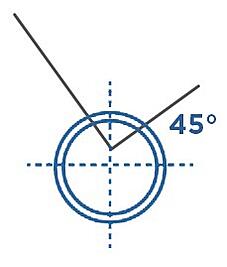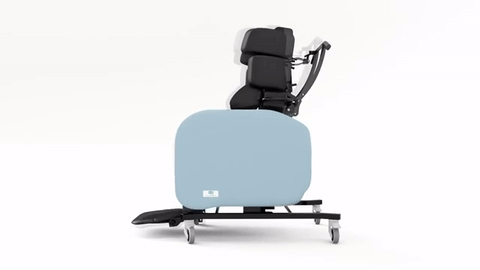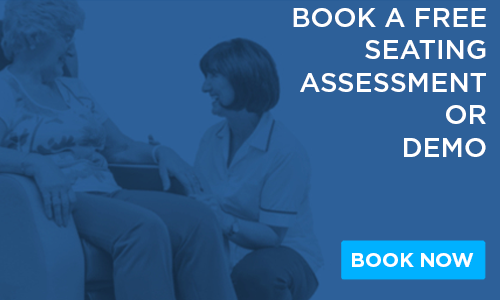- To improve posture.
- To assist with reduced head and trunk control.
- To reduce risk of falls and sliding from chairs.
- To assist with corrective positioning for those with kyphotic postures.
- To improve physiological processes.
- To facilitate easier repositioning by individual/carer.
To Improve Posture
Tilting a patient backwards can help defy the effect of the force of gravity which can have a detrimental effect on posture, pushing down on the body and pulling a patient forward. The act of tilting a patient backwards reduces the effect of gravity and helps to maintain a mid line postural position, preventing postural deviation.
To Redistribute Pressure
For a patient who may be at risk of pressure injuries due to sitting in one position for long periods of time, clinicians focused on wound care such as enterostomal nurses, wound care nurses, tissue viability nurses and also occupational therapists, physiotherapists may use tilt in space to reduce their pressure risk.
Tilt in space is an effective method to redistribute pressure off bony prominences such as the sacrum and ITs. When areas of the body are put under pressure the oxygen levels in cells are reduced due to the mechanical disruption of cell structure and reduced blood flow. This can lead to cell death and the possibility of pressure injuries occurring. Increasing blood flow and re-oxygenating the cells of the affected area can be achieved through offloading pressure on the weight bearing area using features such as tilt in space.
By offloading the pressure in this way regularly, (suggested every 1-2 hours for repositioning) then we are effectively reducing the risk of that skin breakdown and therefore the risk of pressure injuries.
To Assist with Reduced Head and Trunk Control
If a client’s muscle strength is reduced as a result of their physical or mental disability or condition, tilt can help reduce the negative effects on their posture, by keeping their spine, head and thoracic region in mid line. This improves positioning and ultimately, comfort.
Reduce Risk of Falls and Sliding from Chairs
Tilting a patient and changing their centre of gravity contributes to better positioning and therefore reduced risk of falls. In my clinical practice, I’ve found that a tilt position reduces agitation in patients with neurological conditions such as Alzheimer’s, which often contributes to falls from chairs.
Assist Corrective Positioning for those with a Kyphotic Posture
For those patients who have a fixed or flexible spinal contracture such as kyphosis, tilt in space can be really beneficial to support their posture. They may be ‘hunched’ over with limited or no ability to make eye contact with others, due to the position of their spine, then once they are tilted back, their head neck and shoulders are supported, and their visual field improves. This leads to better social inclusion, interaction, communication and increased function.
To Improve Physiological Processes
By sitting upright as opposed to slumping or in a deviated postural position, the patients’ ability to breathe is greatly improved, reducing the risk of respiratory infections. Likewise, other essential bodily functions such as swallowing, digestion and elimination are also improved as a result of this upright positioning.
Easier Repositioning by Individual / Carer
For a person at risk of pressure injuries, who requires constant repositioning, (every 2 hours) a tilt in space chair takes the work out of this task, making it easy and fast to complete by the carer in a swift, controlled motion, or by the patient if they can control their own tile via a powered handset.
-
15°-30°

Research shows that this range of angles can improve positioning, reduce sliding and contribute to increased functional ability.
-
30°– 45°
Larger degrees of tilt are often needed for those at risk of pressure injuries. Evidence shows that the optimum angle for an effective weight shift and therefore pressure management is between 30° and 45°.
Note – Up to 45° tilt is available as an option on all the above chairs excluding the Bariatric Sorrento.
BOOK A FREE SEATING ASSESSMENT WITH YOUR LOCAL SPECIALIST
Note – the purpose of this blog is to give an overview of the product with some tips to consider on its use. This is not intended to be a substitute for professional or medical advice, diagnosis, prescription or treatment and does not constitute medical or other professional advice. For advice with your personal health or that of someone in your care, consult your doctor or appropriate medical professional.** This post was originally published on http://blog.seatingmatters.com/why-use-tilt-in-space



